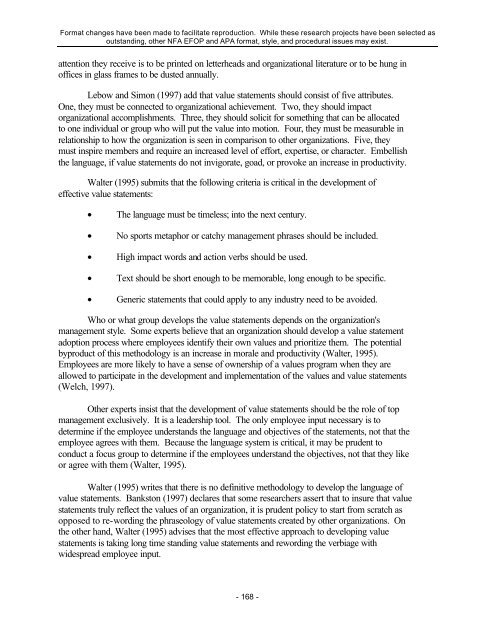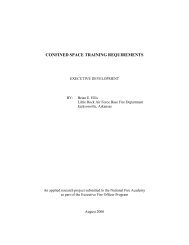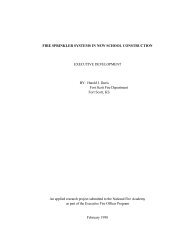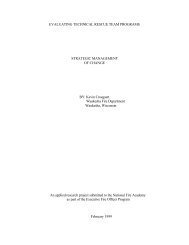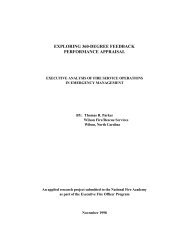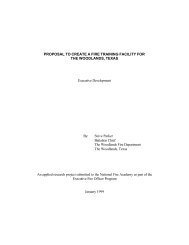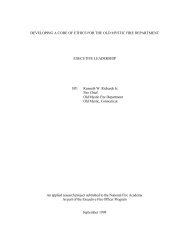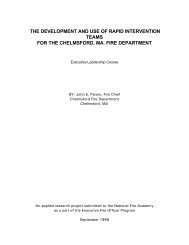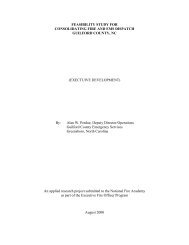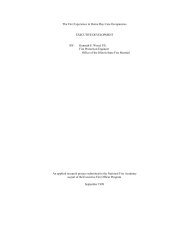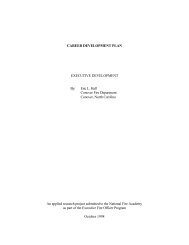Value Statements - US Fire Administration
Value Statements - US Fire Administration
Value Statements - US Fire Administration
You also want an ePaper? Increase the reach of your titles
YUMPU automatically turns print PDFs into web optimized ePapers that Google loves.
Format changes have been made to facilitate reproduction. While these research projects have been selected as<br />
outstanding, other NFA EFOP and APA format, style, and procedural issues may exist.<br />
attention they receive is to be printed on letterheads and organizational literature or to be hung in<br />
offices in glass frames to be dusted annually.<br />
Lebow and Simon (1997) add that value statements should consist of five attributes.<br />
One, they must be connected to organizational achievement. Two, they should impact<br />
organizational accomplishments. Three, they should solicit for something that can be allocated<br />
to one individual or group who will put the value into motion. Four, they must be measurable in<br />
relationship to how the organization is seen in comparison to other organizations. Five, they<br />
must inspire members and require an increased level of effort, expertise, or character. Embellish<br />
the language, if value statements do not invigorate, goad, or provoke an increase in productivity.<br />
Walter (1995) submits that the following criteria is critical in the development of<br />
effective value statements:<br />
• The language must be timeless; into the next century.<br />
• No sports metaphor or catchy management phrases should be included.<br />
• High impact words and action verbs should be used.<br />
• Text should be short enough to be memorable, long enough to be specific.<br />
• Generic statements that could apply to any industry need to be avoided.<br />
Who or what group develops the value statements depends on the organization's<br />
management style. Some experts believe that an organization should develop a value statement<br />
adoption process where employees identify their own values and prioritize them. The potential<br />
byproduct of this methodology is an increase in morale and productivity (Walter, 1995).<br />
Employees are more likely to have a sense of ownership of a values program when they are<br />
allowed to participate in the development and implementation of the values and value statements<br />
(Welch, 1997).<br />
Other experts insist that the development of value statements should be the role of top<br />
management exclusively. It is a leadership tool. The only employee input necessary is to<br />
determine if the employee understands the language and objectives of the statements, not that the<br />
employee agrees with them. Because the language system is critical, it may be prudent to<br />
conduct a focus group to determine if the employees understand the objectives, not that they like<br />
or agree with them (Walter, 1995).<br />
Walter (1995) writes that there is no definitive methodology to develop the language of<br />
value statements. Bankston (1997) declares that some researchers assert that to insure that value<br />
statements truly reflect the values of an organization, it is prudent policy to start from scratch as<br />
opposed to re-wording the phraseology of value statements created by other organizations. On<br />
the other hand, Walter (1995) advises that the most effective approach to developing value<br />
statements is taking long time standing value statements and rewording the verbiage with<br />
widespread employee input.<br />
- 168 -


